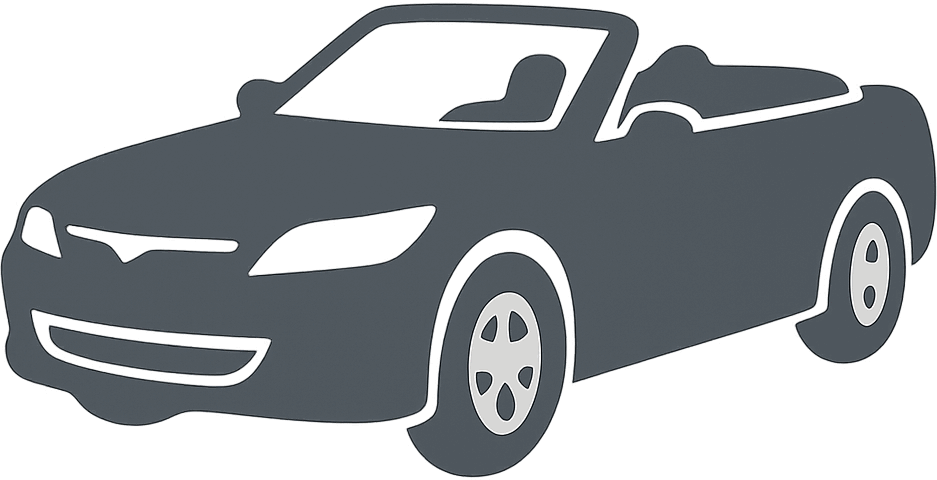 1989 Puma AM4 Dimensions, Size & Specs
1989 Puma AM4 Dimensions, Size & Specs
Measurements of the 1989 Puma AM4, engineered for optimal performance and comfort
| Dimensions | |
|---|---|
| Length: | 4000 mm157.5 in13.1 ft |
| Width: | 1670 mm65.7 in5.5 ft |
| Height: | 1200 mm47.2 in3.9 ft |
| Weight Specifications | |
| Curb Weight: | 905 kg1995 lbs |
| Tire Specifications | |
| Rims Size: |
|
| Tire Size: |
|
The Puma AM4, produced between 1989 and 1995, is a distinctive cabriolet model celebrated for its compact and sporty design. Measuring 4000 mm (157.5 inches) in length, 1670 mm (65.7 inches) in width, and standing just 1200 mm (47.2 inches) tall, the AM4 fits comfortably within the small car segment, ideal for those seeking a nimble roadster with a unique profile. Its lightweight construction at only 905 kg (1995 lbs) enhances its agility and performance on the road. The Puma AM4 rides on 14-inch rims paired with 195/60 R14 tires, striking a balance between grip and comfort. Designed during a period when compact sports cars were gaining popularity, the AM4 is a notable example of Puma's approach to combining aesthetic appeal with practical dimensions. Whether viewed as a collector's item or a classic leisure vehicle, the AM4's size makes it maneuverable in urban environments while maintaining the open-air thrill of a cabriolet. Its elegant proportions and relatively low height contribute to a sleek silhouette, emphasizing an engaging driving experience from both driver and passenger perspectives.
Discover the standout features that make the 1989 Puma AM4 a leader in its class
Have a question? Please check our knowledgebase first.
The Puma AM4 Cabriolet, produced from 1989 to 1995, features compact and sporty dimensions designed to deliver agility and style. Its length measures exactly 4000 mm (approximately 157.5 inches), making it easy to maneuver in urban and tight spaces. The width is 1670 mm (about 65.7 inches), providing a balanced stance on the road without being overly wide. It stands at a low height of 1200 mm (roughly 47.2 inches), which enhances its aerodynamic profile and sports car appeal. These dimensions collectively give the AM4 a sleek and compact presence characteristic of classic cabriolets from the late 80s and early 90s.
The Puma AM4 Cabriolet has a curb weight of 905 kg, which is approximately 1994 pounds. This relatively lightweight construction plays a crucial role in the car’s performance dynamics. The lower weight contributes to better acceleration, improved handling, and enhanced fuel efficiency compared to heavier vehicles. Thanks to this modest weight, the AM4 offers a nimble and responsive driving experience, allowing drivers to enjoy the agility typical of sports cabriolets. The lightweight also aids in reducing wear on tires and brakes, contributing to overall vehicle longevity and maintenance cost savings.
The Puma AM4 is equipped with 14-inch rims paired with tires sized at 195/60 R14. The rim size of 14 inches (about 35.6 cm in diameter) strikes a balance between sporty handling and ride comfort. The tire specification 195/60 indicates a tire width of 195 mm (7.7 inches) with an aspect ratio of 60%, meaning the tire sidewall height is 60% of the width, which supports a cushioned ride while maintaining sufficient grip. These tires contribute to stable traction on various road surfaces, while the moderate rim size helps keep unsprung weight low, enhancing responsiveness and control, especially beneficial in a lightweight cabriolet like the AM4.
Yes, the Puma AM4’s compact dimensions make it suitable for parking in a standard residential garage. With a length of 4000 mm (157.5 inches) and width of 1670 mm (65.7 inches), it fits well within typical garage sizes, which often start at around 5500 mm by 3000 mm (216 inches by 118 inches). The low height of 1200 mm (47.2 inches) also ensures that it can be comfortably accommodated without clearance issues inside most residential garages. This makes the AM4 convenient for owners who live in urban settings or homes with space constraints, providing ease of parking and protection from the elements.
The Puma AM4 represents a distinct generation in Puma’s lineup, and compared to its predecessors, it maintains a compact and sporty form but with refined proportions. Earlier Puma models, particularly those produced before the AM4, sometimes had slightly smaller dimensions or differing styling cues, but the AM4’s 4000 mm length and 1670 mm width place it firmly in the compact sports cabriolet class. This generation was designed with enhanced aerodynamic styling and improved interior spatial design. The low height of 1200 mm was consistent with Puma’s focus on a sleek sports car profile. Overall, the AM4 balanced its predecessors’ small footprint with modernized design and mechanics, appealing to sports car enthusiasts who wanted a lightweight, stylish cabriolet.
When compared to contemporaries like the Mazda MX-5 (NA), the Fiat Barchetta, or the BMW Z3, the Puma AM4’s size is competitive and similarly compact. For example, the first-generation Mazda MX-5 has a length around 3995 mm, nearly identical to the AM4’s 4000 mm. The AM4 is slightly narrower at 1670 mm compared to others like the Z3 which tends to be wider, enhancing its maneuverability. Its low height of 1200 mm is very much in line with sports cabriolet profiles from that era, contributing to an aerodynamic and sporty silhouette. The AM4’s weight of 905 kg is notably light compared to many competitors, which can enhance driving dynamics. Overall, dimensionally the AM4 holds its own, offering classic cabriolet proportions with a focus on lightness and agility.
While the Puma AM4’s exterior height is only 1200 mm (47.2 inches), its cabin is designed with driver and passenger comfort in mind suitable for a sports cabriolet. The seating positions are low and sporty, providing excellent road visibility and an intimate connection to the driving experience. Headroom and legroom are adequate for average-height occupants given the car’s compact size, but tall passengers might find it a bit snug due to the low roofline. The cabriolet design allows for open-air driving, adding to the sense of space. Interior ergonomics focus on accessibility, with controls positioned for ease of reach. The small cabin space aligns with the Puma AM4’s nature as a fun, leisure-oriented vehicle rather than a family car.
Yes, the Puma AM4’s compact size brings distinctive advantages in urban settings and tight parking situations. Its overall length of just 4000 mm (157.5 inches) and narrow width of 1670 mm (65.7 inches) make it easy to maneuver through narrow city streets or congested parking areas. Drivers benefit from a tight turning radius, simplifying U-turns and tight cornering. The low height and lightweight construction also aid in better visibility and control, making it easier to navigate in traffic. Moreover, its small footprint ensures that it can comfortably fit into parking spaces where larger vehicles might struggle, enhancing convenience for day-to-day use in crowded environments.
The 14-inch rim size paired with 195/60 R14 tires is the standard specification for the Puma AM4 Cabriolet throughout its production from 1989 to 1995. This combination was chosen to balance sporty handling characteristics with ride comfort and tire availability. Larger rim sizes were not common on the AM4 generation, as the car’s lightweight and dimensionally compact design did not necessitate bigger wheels. The 195 mm tire width and 60% aspect ratio offer sufficient grip and cushioned handling suitable for both spirited driving and everyday use. While aftermarket modifications exist, the factory standard of 14-inch rims remains the optimal choice for maintaining the vehicle’s intended performance dynamics and aesthetics.
With a curb weight of only 905 kg (about 1994 lbs), the Puma AM4 enjoys numerous advantages over heavier competitors. A lighter weight directly improves acceleration, allowing the engine to propel the vehicle more efficiently. It also positively impacts braking distances, as less mass requires shorter distances to stop. The reduced weight enhances fuel economy, making the AM4 more economical to run compared to similarly sized but heavier cars. Additionally, lower mass leads to less stress on suspension components and tires, often translating into lower maintenance costs and longer component life. The light weight also contributes to excellent handling characteristics, giving the driver a more connected and agile experience, which is especially beneficial in a nimble cabriolet.
